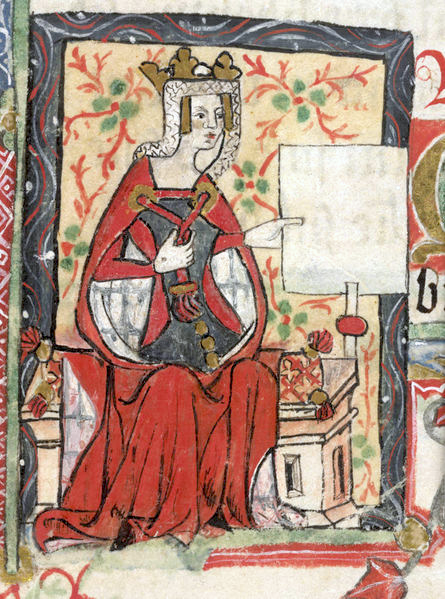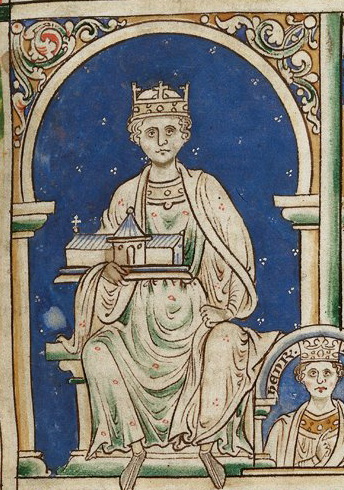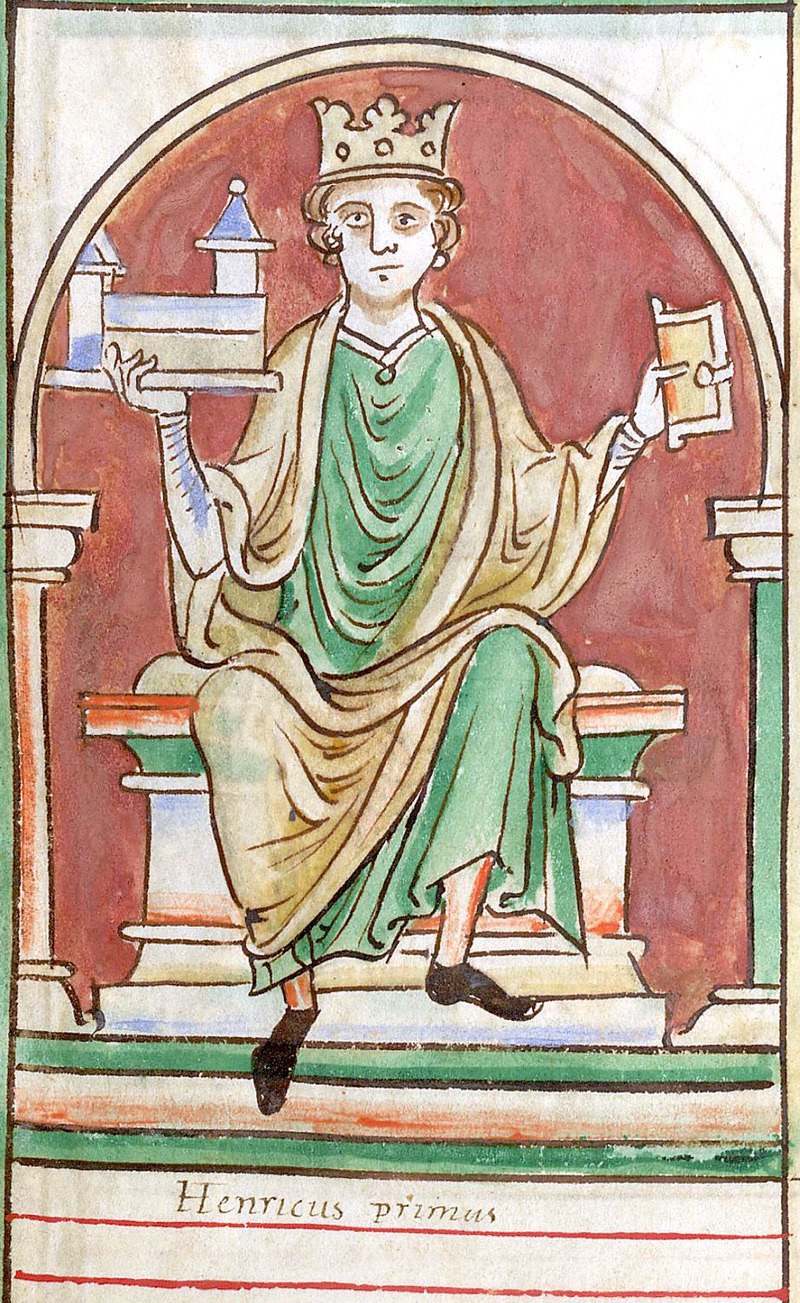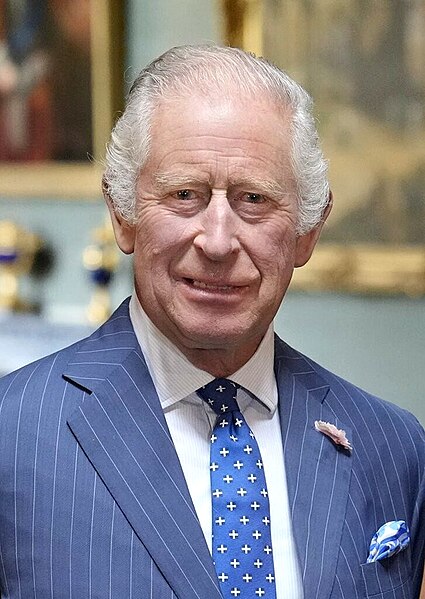by Susan Flantzer
© Unofficial Royalty 2024

1840 drawing of Robert’s effigy in St James’ Priory, Bristol; Credit – Wikipedia
Born circa the late 1080s-1095, Robert FitzRoy, 1st Earl of Gloucester was an illegitimate son of King Henry I of England. His paternal grandparents were King William I of England (the Conqueror) and Matilda of Flanders. Robert was the half-brother of Empress Matilda, Lady of the English (sometimes called Maud or Maude), King Henry I’s only legitimate surviving child, and was her chief military supporter during the long civil war (1135 – 1153) known as The Anarchy, when Matilda unsuccessfully battled with her first cousin Stephen of Blois for the throne of England.

King Henry I of England, the father of Robert FitzRoy, Earl of Gloucester; Credit – Wikipedia
Robert FitzRoy, Earl of Gloucester was probably the eldest of his father’s many illegitimate children and King Henry I recognized him as his son at birth. He was probably born in Caen, then in the Duchy of Normandy, a possession of the English crown, now in France, before his father became King of England in 1100, during the reign of either his paternal grandfather King William I (the Conqueror) or his paternal uncle King William II Rufus. The identity of Robert’s mother is uncertain. Robert’s mother may have been an unknown woman from Caen, Duchy of Normandy. Robert was educated by Robert Bloet, Bishop of Lincoln who educated many noblemen, including illegitimate children of King Henry I. Robert spoke Latin, was interested in philosophy and history, and as an adult, was an active patron of science and art in England. Contemporary chroniclers Geoffrey of Monmouth and William of Malmesbury both dedicated some of their works to Robert.
King Henry I holds the record for the British monarch with the most illegitimate children, 25 or so illegitimate children who were Robert’s half-siblings.
Robert had two royal half-siblings from her father’s marriage with Matilda of Scotland:
- Empress Matilda, Lady of the English (1102 – 1167), married (1) Heinrich V, Holy Roman Emperor, no children (2) Geoffrey V, Count of Anjou, had three sons including King Henry II of England
- William Ætheling, Duke of Normandy (1103 – 1120), married Matilda of Anjou, no children, William Ætheling, King Henry I’s only legitimate son and heir, died in the sinking of the White Ship

Robert and his wife Mabel holding churches or abbeys which they founded or were benefactors of; Credit – Wikipedia
Robert married Mabel FitzRobert (circa 1100 – 1157), the daughter of Robert FitzHamon, Lord of Gloucester and Glamorgan and Sybil de Montgomery. Mabel was the eldest of her father’s four children, all daughters, and because her three younger sisters became nuns, she was the sole heir to her father’s titles and vast estates in England, Wales, and Normandy upon his death in 1107.
Robert and Mabel had at least eight children:
- William FitzRobert, 2nd Earl of Gloucester (1116 – 1183), married Hawise de Beaumont, had five children, including Isabella, 3rd Countess of Gloucester, the first wife of King John of England before he was king, their marriage was annulled
- Roger FitzRobert, Bishop of Worcester (? – 1179)
- Hamon FitzRobert (? – 1159), killed at the Siege of Toulouse
- Robert FitzRobert of Ilchester (? – before 1157), married Hawise de Redvers, had one daughter
- Richard FitzRobert, Lord Creully (? – 1175), married the daughter of Hughes de Montfort, had five children, inherited the Lordship of Creully from his mother Mabel
- Philip FitzRobert, (? – 1147), took part in the Second Crusade
- Matilda FitzRobert (? – 1190), married Ranulf de Gernon, 4th Earl of Chester, had three children.
- Mabel FitzRobert, married Aubrey de Vere
During the latter part of his father’s reign, Robert was the recognized leader of the Welsh border barons and of Norman expansion in southern Wales. His Lordship of Glamorgan which came from his wife, became a model for the economic and political organization of Anglo-Norman possessions in the conquered territories. However, in 1120 an event occurred that would affect the succession to the English throne and have an impact on many people, including Robert – the sinking of the White Ship.

The Sinking of the White Ship; Credit – Wikipedia
Because the Kings of England still held the Duchy of Normandy (now in France) and were Dukes of Normandy, they were often in Normandy, and this was the case in November 1120. After the successful military campaign in which King Henry I of England had defeated King Louis VI of France at the Battle of Brémule, the English were finally preparing to return to England. King Henry I was offered the White Ship for his return to England, but he had already made other arrangements. Instead, King Henry I suggested that his only son and heir William Ætheling, Duke of Normandy sail on the White Ship along with his retinue which included William Ætheling ’s illegitimate half-brother Richard of Lincoln, William Ætheling’s illegitimate half-sister Matilda FitzRoy, Countess of Perche and many of the heirs of the great estates of England and Normandy. Unfortunately, the White Ship hit a submerged rock and capsized. William Ætheling’s bodyguard quickly got the heir to the throne into the safety of a dinghy. However, William Ætheling heard the screams of his half-sister Matilda, Countess of Perche and ordered the dinghy to turn back to rescue her. At this point, the White Ship began to sink and the many people in the water desperately sought the safety of William Ætheling ’s dinghy. The chaos and the weight were too much causing William Ætheling’s dinghy to capsize and sink without a trace. The tragedy of the White Ship resulted in King Henry I losing his only legitimate son and heir and two of his illegitimate children. All three were half-siblings of Robert FitzRoy, Earl of Gloucester. The contemporary chronicler Orderic Vitalis claimed that only two people survived the shipwreck by clinging to a rock all night.

Robert’s half sister Empress Matilda; Credit – Wikipedia
Although King Henry I had many illegitimate children, the tragedy of the White Ship left him with only one legitimate child, his daughter Matilda. King Henry I’s nephews were the closest male heirs. In 1118, King Henry I’s first wife Matilda of Scotland died, aged 38. In January 1121, King Henry I married for a second time to Adeliza of Louvain, hoping for sons, but the marriage remained childless. King Henry I’s daughter 12-year-old daughter Matilda married 23-year-old Heinrich V, Holy Roman Emperor in 1114. The couple had no children, and Heinrich died from cancer on May 23, 1125, at the age of 44, leaving Matilda as a 23-year-old childless widow with the choice of becoming a nun or remarrying. Some offers of marriage started to arrive but Matilda chose to return to her father’s court.
In 1126, King Henry I arranged for his daughter Matilda to marry Geoffrey of Anjou, eldest son of Fulk V, Count of Anjou. Matilda was quite unhappy about the marriage. She was eleven years older than Geoffrey and marriage to a future mere Count would diminish her status as the widow of an Emperor. Nevertheless, the couple was married on June 17, 1128. Matilda and Geoffrey did not get along and their marriage was stormy with frequent, long separations. Matilda insisted on retaining her title of Empress for the rest of her life. In 1129, her husband became Geoffrey V, Count of Anjou when his father left for the Holy Land where he was to become King of Jerusalem. Matilda and Geoffrey had three sons including the future King Henry II of England.
King Henry I’s choice of a successor fell to his daughter Matilda and her successors. On Christmas Day 1126, King Henry I gathered his nobles at Westminster where they swore to recognize Matilda and any future legitimate heirs she might have as his successors. Robert FitzRoy, Earl of Gloucester did homage to his half-sister Matilda, recognizing her as his father’s successor in the kingdom. However, King Henry I’s plan did not work out.

King Stephen of England; Credit – Wikipedia
On December 1, 1135, King Henry I of England died. His nephew Stephen of Blois, the son of King Henry I’s sister Adela of Normandy and Stephen II, Count of Blois, quickly crossed the English Channel, arriving in England accompanied by his military household. With the help of his brother Henry of Blois, Bishop of Winchester, Stephen seized power in England and was crowned King Stephen of England on December 22, 1135, at Westminster Abbey in London. Empress Matilda did not give up her claim to England and Normandy, leading to the long, brutal civil war known as The Anarchy between 1135 and 1153, known as “When Christ and His Saints Slept”.

Matilda’s husband Geoffrey Plantagenet, Count of Anjou; Credit – Wikipedia
For the first few years after the death of his father King Henry I and the usurpation of the crown by his first cousin King Stephen, Robert FitzRoy, Earl of Gloucester was an inactive spectator of the struggle between his half-sister Matilda and his first cousin Stephen for the English throne. In June 1138, Matilda’s husband Geoffrey Plantagenet, Count of Anjou persuaded Robert to join the faction opposing King Stephen. Robert rebelled against King Stephen, starting the beginnings of civil war in England. Meanwhile, Matilda’s husband Geoffrey took advantage of the situation by invading Normandy. Matilda’s maternal uncle King David I of Scotland invaded the north of England and announced that he was supporting the claim of Matilda to the English throne. Matilda gathered an invasion army and landed in England in September 1139 with the support of her half-brother Robert FitzRoy, Earl of Gloucester who served as her commander and several powerful barons.
In 1141, at the Battle of Lincoln where Robert commanded Matilda’s forces, King Stephen was captured, imprisoned, and deposed and Matilda ruled for a short time. Stephen’s brother Henry, Bishop of Winchester turned against his brother and a church council at Winchester declared that Stephen was deposed and declared Empress Matilda “Lady of the English.” Stephen’s wife Matilda of Boulogne rallied Stephen’s supporters and raised an army with the help of William of Ypres, Stephen’s chief lieutenant. Matilda of Boulogne recaptured London for Stephen and forced Matilda to withdraw from the Siege of Winchester, leading to Stephen’s release in 1141 in exchange for Matilda’s half-brother Robert who had also been captured.
By freeing Stephen, Matilda gave up her best chance of becoming Queen of England. The civil war continued for several more years, without much success, with alternate triumphs and defeats. However, it came to a quiet close in 1147 when Matilda’s half-brother Robert FitzRoy, Earl of Gloucester, her valiant commander, died at Bristol Castle in Bristol, England. Robert was buried at St. James’ Priory in Bristol, which he had founded in 1129. Deprived of Robert’s protection, Matilda returned to Normandy in 1147 where she focused on stabilizing the Duchy of Normandy and promoting the rights of her son Henry FitzEmpress, the future King Henry II, to the English throne.

Matilda’s son King Henry II of England; Credit – Wikipedia
Although Robert, Earl of Gloucester did not achieve his goal of seeing his half-sister become Queen of England, Matilda lived long enough to see her son Henry FitzEmpress firmly established on the English throne. In the 1154 Treaty of Winchester, King Stephen recognized Matilda’s son Henry FitzEmpress as his heir. Stephen died on October 25, 1154, and Henry ascended the throne as King Henry II, the first King of England from the House of Angevin. Matilda spent the rest of her life in Normandy, often acting as King Henry II’s representative and presiding over the government of the Duchy of Normandy. She died, aged about 65, on September 10, 1167, in Rouen, Duchy of Normandy, now in France.
Robert FitzRoy, Earl of Gloucester, Empress Matilda, King Stephen, and their families are characters in the late Sharon Kay Penman‘s excellent historical fiction novel When Christ and His Saints Slept about the civil war, The Anarchy. The years of the civil war fought by Matilda and Stephen also serve as a backdrop for Ellis Peters‘ historical detective series about Brother Cadfael, set between 1137 and 1145.
This article is the intellectual property of Unofficial Royalty and is NOT TO BE COPIED, EDITED, OR POSTED IN ANY FORM ON ANOTHER WEBSITE under any circumstances. It is permissible to use a link that directs to Unofficial Royalty.
Works Cited
- Beauclerk-Dewar, Peter, & Powell, Roger. (2006). Right Royal Bastards – The Fruits of Passion. Burke’s Peerage & Gentry LLC.
- Flantzer, Susan. (2017). Empress Matilda, Lady of the English. Unofficial Royalty. https://www.unofficialroyalty.com/empress-matilda-lady-of-the-english/
- Flantzer, Susan. (2015). King Henry I of England. Unofficial Royalty. https://www.unofficialroyalty.com/king-henry-i-of-england/
- Robert de Caen 1st Earl of Gloucester. Genealogics. (n.d.). https://www.genealogics.org/getperson.php?personID=I00027782&tree=LEO
- Weir, Alison. (2008). Britain’s Royal Families – The Complete Genealogy. Vintage Books.
- Wikimedia Foundation. (2023). Robert, 1st Earl of Gloucester. Wikipedia. https://en.wikipedia.org/wiki/Robert,_1st_Earl_of_Gloucester
- Williamson, David. (1996). Brewer’s British Royalty: A Phrase and Fable Dictionary. Cassell.























 Just hours after it was announced that The Princess of Wales had undergone successful abdominal surgery, Buckingham Palace announced that King Charles III will be treated for a benign prostate condition next week. The statement stresses that it is a benign condition, but the King will undergo a “corrective procedure”. The King’s engagements will be postponed for a brief period of time.
Just hours after it was announced that The Princess of Wales had undergone successful abdominal surgery, Buckingham Palace announced that King Charles III will be treated for a benign prostate condition next week. The statement stresses that it is a benign condition, but the King will undergo a “corrective procedure”. The King’s engagements will be postponed for a brief period of time.